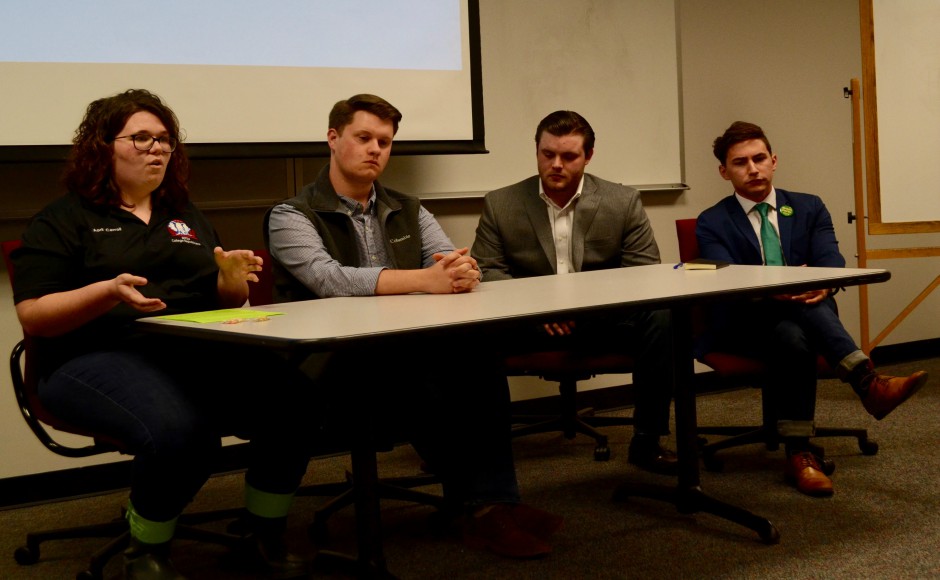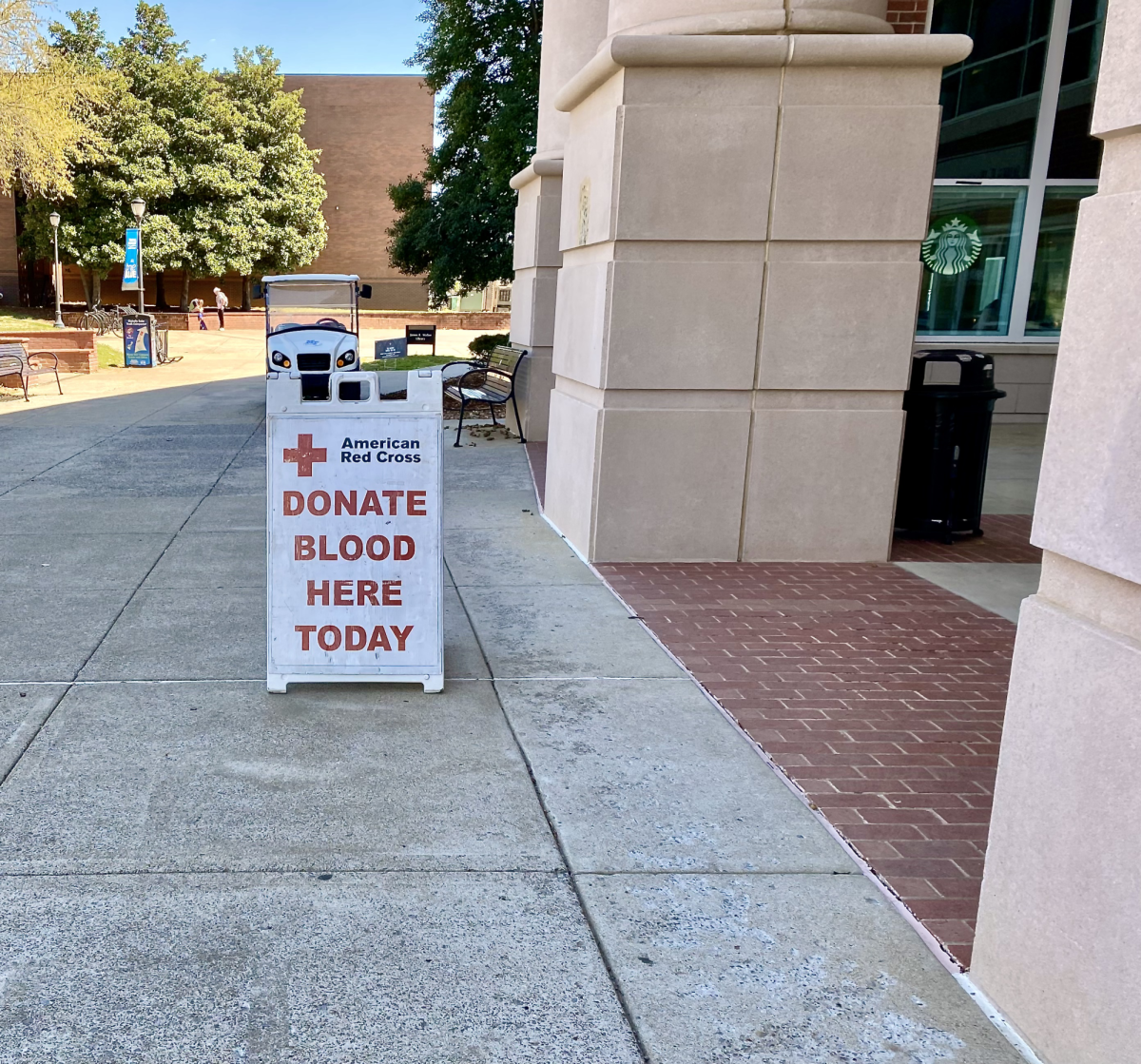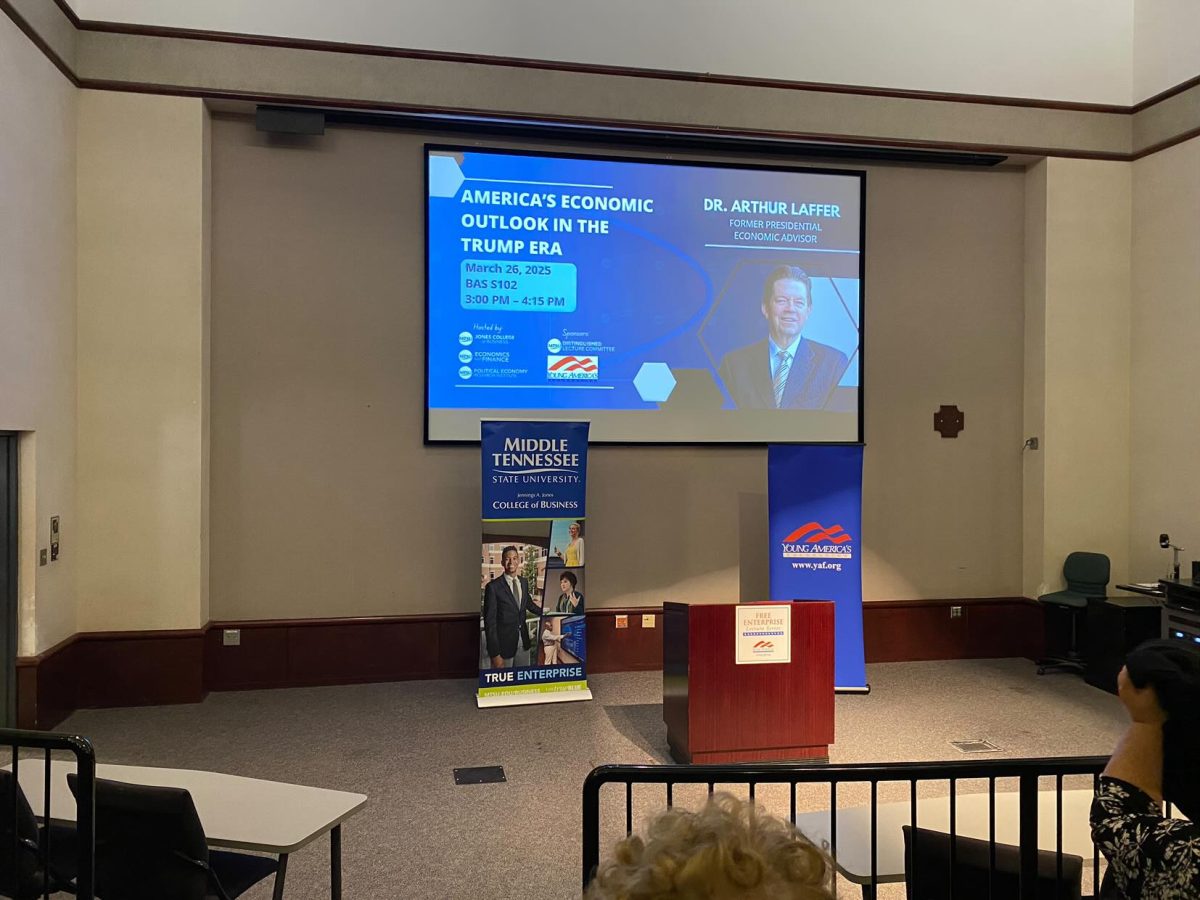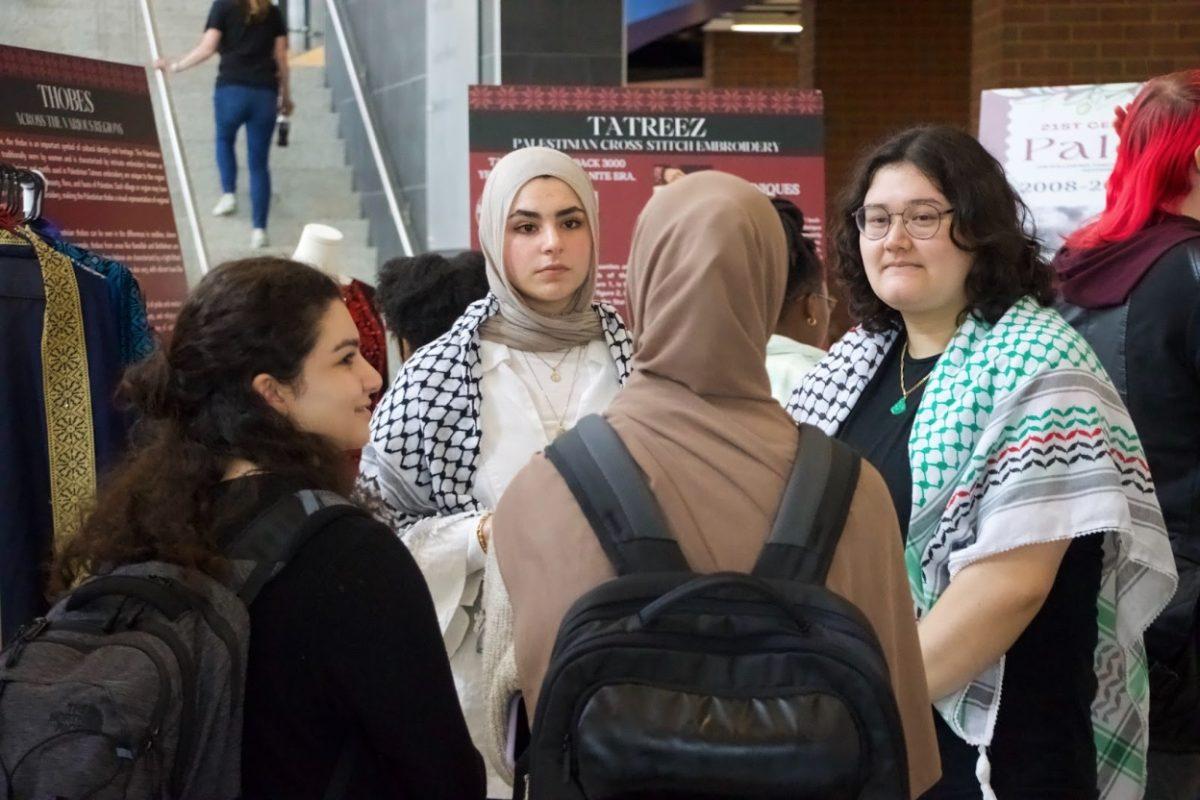Photo and Story by Robin Duff / Contributing Writer
Get to Know the Parties, a town hall event with the purpose of encouraging students to be educated about political organizations on campus, was held in the Business and Aerospace Building on Thursday.
The panel, moderated by MT10 News Director Katie Inman, was attended by the MTSU College Democrats, College Republicans, Young Greens and Turning Point USA, a Libertarian group.
The town hall started at 7 p.m., with the first question directed toward the College Democrats.
Inman asked, “As a campus organization that claims to advocate for unity, how do you justify the bashing of right-leaning individuals and organizations while simultaneously claiming to be the only organization on campus that seeks to end divisiveness?”
College Democrats President Dalton Slatton answered by stating that he does not believe that the organization is a bashing group but that the debate between parties can sometimes be seen as inflammatory.
“There are times that we have to draw a distinct difference between Republicans and Democrats [because of our conflicting] values and beliefs,” Slatton said. “I don’t think that we’re a bashing group on campus, and we do try to include everyone.”
The next question asked by Inman was directed at the Young Greens.
“As a smaller party organization that has made its name in hoping to unite the left, the unspoken here is that this unity would be in direct opposition to right. How do you justify working with those across the aisle to facilitate bipartisan solutions and discussions while staking your ground in the fact that the right is the enemy?”
Young Greens President Zach Looney replied that the Green Party works towards bipartisan solutions out of necessity.
“It’s imperative that we come up with bipartisan solutions because that’s what we have to do to pass any legislation,” Looney said. “It’s very difficult in American politics to pass any kind of legislation unilaterally.”
Inman then moved to a question for Turning Point USA.
“Turning Point initially advertised itself as a Libertarian leaning organization that was dedicated to uniting conservative activists while also advocating for bipartisanship. Recently, the national organization has taken a stance in strong support of inflammatory stances that bash anyone who disagrees with President Trump and denounces them or anyone moderate as ‘liberal snowflakes.’ How do you justify the rhetoric while also advocating for unity within the conservative camp?”
Turning Point Chapter President Dalton Cantrell conceded that some chapters behave this way because they find they find it difficult separating themselves from their personal views but stated that he does not run the MTSU chapter that way.
“I keep it as bipartisan as possible,” Cantrell said. “I try to keep everything open minded.”
Inman posed the next question to College Republicans President April Carroll.
“How do you justify balancing conservative principles with the enigma of the present administration, which has expressed disdain for the greater party establishment. In other words, how do you justify and balance supporting the party while simultaneously supporting a president who continues to bash the party and all right-leaning individuals who ask him tough questions or disagree on the slightest issue?”
Carroll stated that she believes that all parties, especially the GOP, should maintain a level of respect for the office of the president, even if they disagree politically.
“We respect most of the views he has on certain issues,” Carroll said. “Whether we disagree with him on the little things or not, he still is the Republican president.”
Circling back to the College Democrats, Inman asked, “Where does the Democratic Party draw the line on opposing Trump?”
“I think we have to pick our battles in regard to the president’s legislation,” Slatton answered.
Slatton expressed concern that some Democratic legislators oppose President Trump’s policies, whatever the substance, because they come from a Republican.
“There’s a certain balance that we have to strive for between opposing legislation and doing our job, and I don’t think the Democratic party on the national level has found that yet,” Slatton said.
Inman turned to Looney and the Young Greens next, asking, “Why do Greens act so harshly in their criticism of the Democrats?”
Looney attributed the Green Party’s criticism of the the Democrats to the party’s failure to take a more progressive stance.
“Our goal is to make America a more progressive society,” Looney said. “Part of the way we do that is by calling out the Democrats on the areas where we find that they’re not progressive enough.”
Next Inman asked Cantrell, “What can the Libertarian Party do to shake the goofy associations made due to fictional characters like Ron Swanson and even Gary Johnson?”
Cantrell stated that, in a way, the Libertarian party has benefitted from the depiction of Libertarian characters on TV, as it drew attention to the party as a whole.
“When you’re a third party, sometimes you want to take the free advertisement,” Cantrell said.
The next questions were directed at the panel as a whole. The first was about healthcare and was simply, “Healthcare. What now?”
Carroll answered first, saying, “We need to simplify the system and reduce the mandates that are required on insurances. [Reducing mandates will] enable insurance providers to be able to increase the healthcare options while containing the costs.”
Slatton, to contrast, defended Obamacare.
“I do not think that we need to repeal and replace Obamacare,” he said. “I think we need to have Republicans come to the table with Democrats and fix what’s wrong with Obamacare rather than repealing it all and starting fresh with a new system.”
Cantrell stated that the problem with healthcare is the government involvement in the system.
“If we truly believe that everyone needs healthcare, we need to reduce the size of healthcare,” he said. “The government has encroached too far into healthcare.”
Looney went on to say that the profit-driven nature of insurance and pharmaceutical companies is what drives up prices.
“What the Green Party platform suggests is a single-payer system where you don’t have deductibles or make monthly payments. It comes out of your taxes like everything else,” Looney said. “And from cradle to grave, everyone is covered.”
Inman moved to the next question, which was about climate change.
“What are your parties’ official stances on climate change?”
“We need more recent studies from a diverse group of scientists,” Carroll answered. “Let’s hear more research, and let’s fix the things that the right and left agree on.”
Slatton expressed a different view.
“[Democrats] believe that there is such a thing as climate change,” he said. “We supported the Paris Agreement for climate change. We supported measures that reduce CO2. We want to move toward clean, renewable energy.”
Cantrell agreed with the idea of using more renewable energies but that a marketable industry has to be created for green energy.
“A lot of these [green energy] companies are creating technology that’s actually making a difference, but not on a broad scale. In order to fix the issue, we have to fund that kind of industry,” Cantrell said.
Looney reminded the audience that the Green Party was founded on a platform that aimed to halt climate change.
“The Green Party’s stance on climate change is that it is happening, it is man-caused and that we really don’t have a choice but to correct this issue or it’s going to have some serious consequences,” Looney said.
Looney went on to explain the party’s Green New Deal, which would lower the national unemployment rate by creating jobs in the green energy industry.
The last prepared question was about college tuition rates.
Inman asked, “So many students are feeling the burden of college tuition. What do your parties propose we do?”
“The federal government should not be in the business of originating student loans,” Carroll stated. “We believe that giving students access to a multitude of financial options and private sector participation will drive down the interest rates on student loans.”
Slatton expressed a more moderate view than some Democrats, saying that he does not believe college tuition should be totally paid for by the government.
“I think the best plan is a way to help subsidize the cost of tuition, keep tuition rates from going up with some assistance, but be invested in yourself and value your education,” he said.
Cantrell placed emphasis on encouraging students to consider technical labor schools as well as traditional college education.
“We’re going to bring back the relevance of tech schools and trade schools, because those things have been long forgotten,” he said. “We need to start preparing people for a career.’
Looney stated that the Green Party would eliminate student debt by creating federally funded universities.
“The Green Party platform stands on the idea that we need to have fully funded universities paid for by the federal government,” Looney said.
Finally, the presidents of each organization explained why they thought students should join their groups.
“College Republicans is the organization that tries to bring all the right-leaning individuals together,” Carroll said. “If you are anywhere on the right of the spectrum, College Republicans would love to help you.”
“If you are left-leaning on campus and you identify with the Democratic Party platform, you should come to Democrats meetings,” Slatton said. “We try to be the party of inclusion.”
“If you don’t know where you belong, please come to me,” Cantrell said. “I focus on political theory and I want to help you figure out where you belong.”
“If you’re on the left and you feel like your voice isn’t heard inside the Democratic party or if you feel like the groups on the right or in the middle aren’t hearing your concerns, that’s what we’re here for,” Looney said. “We’re here for the people on the left who want to be heard.”
For more information on the College Republicans, College Democrats, Young Greens and Turning Point USA, follow these links:
For more news, follow us at www.mtsusidelines.com, on Facebook at MTSU Sidelines and on Twitter at @Sidelines_News.
To contact News Editor Brinley Hineman, email newseditor@mtsusidelines.com








